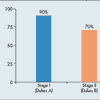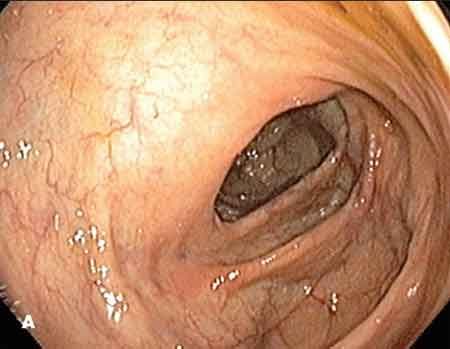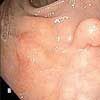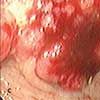- Clinical Technology
- Adult Immunization
- Hepatology
- Pediatric Immunization
- Screening
- Psychiatry
- Allergy
- Women's Health
- Cardiology
- Pediatrics
- Dermatology
- Endocrinology
- Pain Management
- Gastroenterology
- Infectious Disease
- Obesity Medicine
- Rheumatology
- Nephrology
- Neurology
- Pulmonology
Colorectal Cancer Screening: Which Tests, How Often?
ABSTRACT: Screening options for colorectal cancer (CRC) include colonoscopy every 10 years, annual fecal occult blood testing, flexible sigmoidoscopy every 5 years, or double contrast barium enema every 5 years. In white patients at average risk, screening should begin at age 50; in African American patients, at age 45. Colonoscopy is preferred to sigmoidoscopy because it can detect proximal neoplasms and has the longest protection interval. High-risk patients include those with a family history of CRC or adenomas. These persons should begin colonoscopic screening at age 40, or 10 years earlier than the age at which CRC or adenomas were diagnosed in a first-degree relative. Other high-risk patients are those with a personal history of CRC, a genetic syndrome, or inflammatory bowel disease. In patients with CRC, the first follow-up colonoscopy is performed 1 year after surgery. If results are normal, the interval can be extended to every 3 years.
Colorectal cancer (CRC) is the fourth most common newly diagnosed internal cancer in the United States (after breast, prostate, and lung cancer), and the second most common cause of cancer-related death (second only to lung cancer). More than 148,000 new cases ofCRC are diagnosed annually in the United States, and more than 55,000 patients die of this disease yearly.1

Figure 1
Increased understanding of the molecular and biologic characteristics of CRC has provided useful insights into the pathogenesis and primary prevention of colonic neoplasms. Because these cancers develop over long periods, preneoplastic and early neoplastic lesions can be detected earlier, thus improving survival rates (Figure 1). Despite the reduction in morbidity and mortality with regular screening and surveillance, screening rates remain low. In 2001, the CDC Behavioral Risk Factor Surveillance System estimated that only 53.1% of persons older than 50 years had undergone a fecal occult blood test (FOBT) in the past year or a screening colonoscopy in the past 10 years.2,3

Figure 2A

Figure 2B
In this article, we review the current screening and surveillance guidelines.
NATURAL HISTORY OF CRC
Most CRC arises from adenomatous polyps (tubular adenomas or villous or tubulovillous adenomas); hyperplastic polyps almost never become cancerous. The larger the polyp and the greater the villous component, the higher the risk of eventual transformation to cancer. The transformation of polyp to CRC usually takes 5 to 10 years (Figure 2). The exception is hereditary nonpolyposis colon cancer (HNPCC [Lynch syndrome]); polyps associated with this syndrome can become cancerous within 1 to 2 years.4
SCREENING MODALITIES
The advantages and disadvantages of the screening modalities for CRC are discussed below. Of course, any screening test is better than none at all.Currently, a single digital rectal examination, virtual colonoscopy, and fecal DNA testing are not considered acceptable screening tools.

Figure 2C
Fecal occult blood test (FOBT). Tests such as Hemoccult and Hemoccult II have been widely studied and utilized clinically. Large controlled studies of asymptomatic patients from the United States, Great Britain, and Scandinavia have reported a positive result rate of 1% to 2.6% on the first screening and a predictive value for colonic neoplasms of 22% to 58%. The risk of mortality with biennial FOBT screening was reduced by 21%, 15%, and 18%, respectively.5,6
The limitations of FOBT include low sensitivity and a high false-positive rate. The test should be done annually, but many patients balk at handling stool. Any food containing pseudoperoxidase or associated with peroxidase activity (including rare red meat and uncooked fruits and vegetables, such as broccoli, turnips, cauliflower, radishes, and cantaloupe) can produce a false-positive result. Such foods should be avoided for 3 days before and during testing. Although rehydration increases sensitivity, this is usually not recommended for screening average-risk populations, because it increases the false-positive rate. There is also a high false-negative rate with FOBT because adenomas and cancers may bleed only intermittently. Antioxidants such as vitamin C may also produce false-negative results.7-9
Because 2 mL of blood loss per day into the stool is necessary to produce a positive result, 2 samples of each of 3 consecutive (daily) stools should be tested. Right-sided cancers produce fewer false-negative tests than cancers elsewhere in the colon, because large, bulky tumors bleed more frequently.9,10
Although better than no testing at all, FOBT alone is not recommended as the first choice for CRC screening by the American College of Gastroenterology (ACG) because of its limitations.7
Flexible sigmoidoscopy. The benefit of proctosigmoidoscopy in screening programs for CRC was suggested by several uncontrolled studies that used the rigid proctosigmoidoscope. These studies reported a reduced risk of mortality of 60% for cancers within the reach of this 20-cm instrument.11
The advantages of this procedure include the fact that it can be done in the office, it is more effective than FOBT at detecting polyps and adenomas, it does not require sedation, and the preparation is simpler than with colonoscopy. Moreover, there are more clinicians trained to do this procedure than colonoscopy. The disadvantages include the fact that it is less effective than colonoscopy, there is some patient discomfort, and the procedure carries a small risk of perforation.10,11
Double (air) contrast barium enema (DCBE). This modality has been included as an option in a variety of screening guidelines. No studies, however, have directly addressed the effectiveness of DCBE for CRC screening. Several reports have shown that DCBE is less sensitive than colonoscopy, especially for lesions smaller than 1 cm.
The other disadvantages of DCBE include poor patient tolerance, an unknown optimal screening interval, and the need for bowel preparation. There is also an associated perforation risk, although it is much lowerthan with colonoscopy. Radiologists' expertise in performing this study is diminishing because the procedure is being performed less frequently.12
Colonoscopy. This may be the most cost-effective tool for screening, although prospective randomized trials are lacking.The National Polyp Study demonstrated a significant reduction in CRC incidence with colonoscopic removal of adenomatous polyps.13,14 Because proximal neoplasms can occur in the absence of distal neoplasms, colonoscopy is preferred to sigmoidoscopy. This advantage was demonstrated in 2 trials, in which about half of persons with advanced proximal neoplasms (adenomas larger than 1 cm, adenomas with villous features or dysplasia, or cancer) had no distal neoplasms.15,16 Furthermore, colonoscopy is the only method used to remove polyps without surgery, has the longest protection interval, and has better patient acceptance than flexible sigmoidoscopy (because sedation is administered).
However, colonoscopy has the highest complication rate, with a perforation risk of 0.03% to 0.61% in diagnostic studies and 0.07% to 0.72% in therapeutic examinations. It also is the most expensive. Compliance involves fasting, bowel preparation, and the discontinuation of certain medications before the procedure. The detection rates of polyps and cancers are also a function of the quality of the preparation and other factors during the procedure itself.7,17 Even in expert hands and with excellent bowel preparation, colonoscopy can miss neoplasms--for example, small, flat lesions or polyps hidden behind haustral folds or around corners, such as the hepatic flexure. Fortunately, the miss rate is very low.
Virtual colonoscopy. This technique involves the use of helical CT to generate high-resolution 2-dimensional images of the abdomen and pelvis. Three-dimensional images of the colon are then reconstructed by a computer off-line. This modality has the potential advantage of being a rapid and safe method for evaluating the entire colon. Current limitations are its low sensitivity and specificity, need for bowel preparation, and insufflation of the colon (which can cause perforation). Sensitivity and specificity can be increased through the use of fecal tagging with oral and intravenous contrast. With improved high-resolution scanners, improved fecal tagging, and a "prep-less" study, this modality may become an important screening method. It is currently not reimbursed by most insurers.18,19
Fecal DNA testing. This method is 4 times more sensitive than FOBT; however, it is only half as sensitive as colonoscopy in average-risk patients. In one small study, sensitivity ranged from 62% to 91% in patients with advanced symptomatic cancers.20 With improvement, this modality may be an important screening tool in the future.7,20
RISK FACTORS FOR CRC
Patients are classified as at average or high risk. The average-risk group consists of persons older than 50 years with no known risk factors. However, the ACG recommends that African Americans begin screening at age 45 years. This recommendation is based on epidemiologic data that show that CRC in African Americans occurs at earlier ages (10.6% before age 50 years) than in whites, has a higher incidence and a more proximal distribution in the colon, is more aggressive, and has a lower survival rate.21
The high-risk group consists of patients with a personal or family history of CRC or adenomas, a genetic syndrome, or inflammatory bowel disease (IBD). The 2 major genetic syndromes are familial adenomatous polyposis (FAP) and the hereditary nonpolyposis colorectal cancer syndrome (HNPCC).4
CRC SCREENING STRATEGIESAverage-risk patients. The American Society for Gastrointesti- nal Endoscopy7 and the ACG22 both recommend colonoscopy as the preferred modality (Table 1). These groups recommend that initial screening begin at age 50 years for whites. However, the ACG recommends that initial screening begin at age 45 years for African Americans.
The American Gastroenterology Association and American Cancer Society consider any of the following acceptable: colonoscopy every 10 years, annual FOBT, flexible sigmoidoscopy every 5 years, a combination of flexible sigmoidoscopy every 5 yearsand annual FOBT, or DCBE every 5 years.7,17,23
High-risk patients. The following strategies are recommended (Table 2):
- Family history of CRC: Colonoscopy at age 40 years, or 10 years earlier than the age at diagnosis of CRC or adenomatous polyps in a first- degree relative. If the screening examination results are negative, the next screening should be performed in 5 years.7,23,24
- IBD: Colonoscopy every 1 to 2 years for 8 to 10 years after the onset of proctocolitis and 15 years after the onset of left-sided colitis only.24,25
- FAP:Annual sigmoidoscopy starting at age 10 to 12 years. If a genetic abnormality is identified in the index case, family members are tested. If the results of genetic testing are negative in a family member, flexible sigmoidoscopy is recommended every 7 to 10 years. If no polyps are found until age 40 years, the patient is screened as if at average risk.4,26 Patients with attenuated FAP have a later onset of polyposis and fewer polyps. They can begin annual colonoscopy in their late teens.
- HNPCC:Colonoscopy every 1 to 2 years starting at age 20 to 25 years or 10 years younger than the age at which CRC was diagnosed in the youngest family member.Genetic testing results, if positive in the index case, can help determine the need for further screening.4,26
SURVEILLANCE OF COLONIC POLYPS AND CRC
Surveillance colonoscopy is required in patients with adenomatous polyps or CRC. Historically, adenomatous polyps were followed with annual colonoscopies. The results of the National Polyp Study demonstrated that annual follow-up was unnecessary.Factors that determine the screening interval include the quality of the baseline colonoscopy and the number, size, histologic features, and location of polyps.7,17
The following surveillance strategies are recommended:
•Patients with hyperplastic polyps that are not part of a hyperplastic polyposis syndrome are considered to have normal colonoscopy results and do not need a repeated colonoscopy for 10 years.27
•For patients with 1 or 2 adenomatous polyps smaller than 1 cm and low-grade dysplasia, the next screening should be in 5 to 10 years.7
•Patients with 3 to 10 adenomas, or any adenoma with high-grade dysplasia or villous features, or any adenoma larger than 1 cm should have a follow-up colonoscopy in 3 years, provided the entire polyp was removed in a non-piecemeal manner.7
•Patients with more than 10 adenomas at one examination should be screened at shorter intervals, as determined by the endoscopist, and should be evaluated for an underlying polyposis syndrome.7
•Patients with sessile adenomas removed piecemeal should have a follow-up colonoscopyin 2 to 6 months to verify complete removal. Subsequent surveillance is individualized based on the endoscopist's judgment.7
•For patients with a first-degree relative in whom CRC or an adenomatous polyp was diagnosed before age 60 years, the screening interval is 3 to 5 years if results of the screening colonoscopy are normal. If the diagnosis in the first-degree relative was made after age 60 years, the interval after a normal colonoscopy can be extended to 10 years.7,28
•In patients with a personal history of CRC, the first follow-up colonoscopy should be performed 1 year after surgery. If the results are normal, the interval can be extended to every 3 years.7,29
FOBT is not recommended in patients undergoing endoscopic surveillance or between colonoscopic screenings, because of the high incidence of false-positive results.
References:
REFERENCES:
1.
Jemal A, Siegel R, Ward E, et al. Cancer statistics, 2006.
CA Cancer J Clin
. 2006;56:106-130.
2.
Sirovich BE, Schwartz LM, Woloshin S. Screening men for prostate and colorectal cancer in the United States: does practice reflect the evidence?
JAMA
. 2003;289:1414-1420.
3.
Loeve F, Brown ML, Boer R, et al. Endoscopic colorectal cancer screening: a cost-saving analysis.
J Natl Cancer Inst
. 2000;92:557-563.
4.
Johns LE, Houlston RS. A systematic review and meta-analysis of familial colorectal cancer risk.
Am J Gastroenterol
. 2001;96:2992-3003.
5.
Mandel JS, Bond JH, Church TR, et al. Reducing mortality from colorectal cancer by screening for fecal occult blood. Minnesota colon cancer control study.
N Engl J Med
. 1993;328:1365-1371.
6.
Mandel JS, Church TR, Ederer F, Bond JH. Colorectal cancer mortality: effectiveness of biennial screening for fecal occult blood.
J Natl Cancer Inst
. 1999;91:434-437.
7.
Davila RE, Rajan E, Baron TH, et al. ASGE guideline: colorectal cancer screening and surveillance.
Gastrointest Endosc
. 2006;63:546-557.
8.
Kahi CJ, Rex DK. Current and future trends in colorectal cancer screening.
Cancer Metastasis Reviews
. 2004;23:137-144.
9.
Winawer S, Fletcher R, Rex D, et al. Colorectal cancer screening and surveillance: clinical guidelines and rationale--update based on new evidence.
Gastroenterology
. 2003;124:544-560.
10.
Winawer SJ, Fletcher RH, Miller L, et al. Colorectal cancer screening: clinical guidelines and rationale.
Gastroenterology
. 1997;112:594-642.
11.
Muller AD, Sonnenberg A. Prevention of colorectal cancer by flexible endoscopy and polypectomy. A case-control study of 32,702 veterans.
Ann Intern Med
. 1995;123:904-910.
12.
Rex DK, Rahmani EY, Haseman JH, et al. Relative sensitivity of colonoscopy and barium enema for detection of colorectal cancer in clinical practice.
Gastroenterology
. 1997;112:17-23.
13.
Winawer SJ, Zauber AG, Ho MN, et al. Prevention of colorectal cancer by colonoscopic polypectomy. The National Polyp Study workgroup.
N Engl J Med
. 1993;329:1977-1981.
14.
Winawer SJ, Zauber AG, O'Brien MJ, et al. Randomized comparison of surveillance intervals after colonoscopic removal of newly diagnosed adenomatous polyps. The National Polyp Study workgroup.
N Engl J Med
. 1993;328:901-906.
15.
Imperiale TF, Wagner DR, Lin CY, et al. Risk of advanced proximal neoplasms in asymptomatic adults according to the distal colorectal findings.
N Engl J Med
. 2000;343:169-174.
16.
Lieberman DA, Weiss DG, Bond JH, et al. Use of colonoscopy to screen asymptomatic adults for colorectal cancer. Veterans Affairs Cooperative Study Group 380.
N Engl J Med
. 2000;343:162-168.
17.
Levin B, Barthel JS, Burt RW, et al. Colorectal Cancer Screening Clinical Practice Guidelines.
J Natl Compr Canc Netw
. 2006;4:384-420.
18.
Fenlon HM, Nunes DP, Schroy PC III, et al. A comparison of virtual and conventional colonoscopy for the detection of colorectal polyps.
N Engl J Med
. 1999;341:1496-1503.
19.
Chaoui AS, Blake MA, Barish MA, Fenlon HM. Virtual colonoscopy and colorectal cancer screening.
Abdom Imaging
. 2000;25:361-367.
20.
Ahlquist DA, Skoletsky JE, Boynton KA, et al. Colorectal cancer screening by detection of altered human DNA in stool: feasibility of a multitarget assay panel.
Gastroenterology
. 2000;119:1219-1227.
21.
Agrawal S, Bhupinderjit A, Bhutani MS, et al. Colorectal cancer in African Americans.
Am J Gastroenterol.
2005;100:515-523.
22.
Rex DK, Johnson DA, Lieberman DA, et al. Colorectal cancer prevention 2000: screening recommendations of the American College of Gastroenterology.
Am J Gastroenterol.
2000;95:868-877.
23.
Davila RE, Rajan E, Adler D, et al. ASGE guideline: the role of endoscopy in the diagnosis, staging, and management of colorectal cancer.
Gastrointest Endosc
. 2005;61:1-7.
24.
Hanauer SB, Sandborn W. Practice Parameters Committee of the American College of Gastroenterology. Management of Crohn's disease in adults.
Am J Gastroenterol
. 2001;96:635-643.
25.
Kornbluth A, Sachar DB. Practice Parameters Committee of the American College of Gastroenterology. Ulcerative colitis practice guidelines in adults (update). American College of Gastroenterology, Practice Parameters Committee.
Am J Gastroenterol
. 2004;99:1371-1385.
26.
Galiatsatos P, Foulkes WD. Familial adenomatous polyposis.
Am J Gastroenterol
. 2006;101:385-398.
27.
Rubio CA, Stemme S, Jaramillo E, Lindblom A. Hyperplastic polyposis coli syndrome and colorectal carcinoma.
Endoscopy
. 2006;38:266-270.
28.
Winawer SJ, Zauber AG, Gerdes H, et al. Risk of colorectal cancer in the families of patients with adenomatous polyps. National Polyp Study workgroup.
N Engl J Med
. 1996;334:82-87.
29.
Byers T, Levin B, Rothenberger D, et al. American Cancer Society guidelines for screening and surveillance for early detection of colorectal polyps and cancer: update 1997. American Cancer Society Detection and Treatment Advisory Group on Colorectal Cancer.
CA Cancer J Clin.
1997;47:154-160.
30.
American Cancer Society.
Cancer Facts and Figures 2003.
Atlanta: American Cancer Society; 2003.
